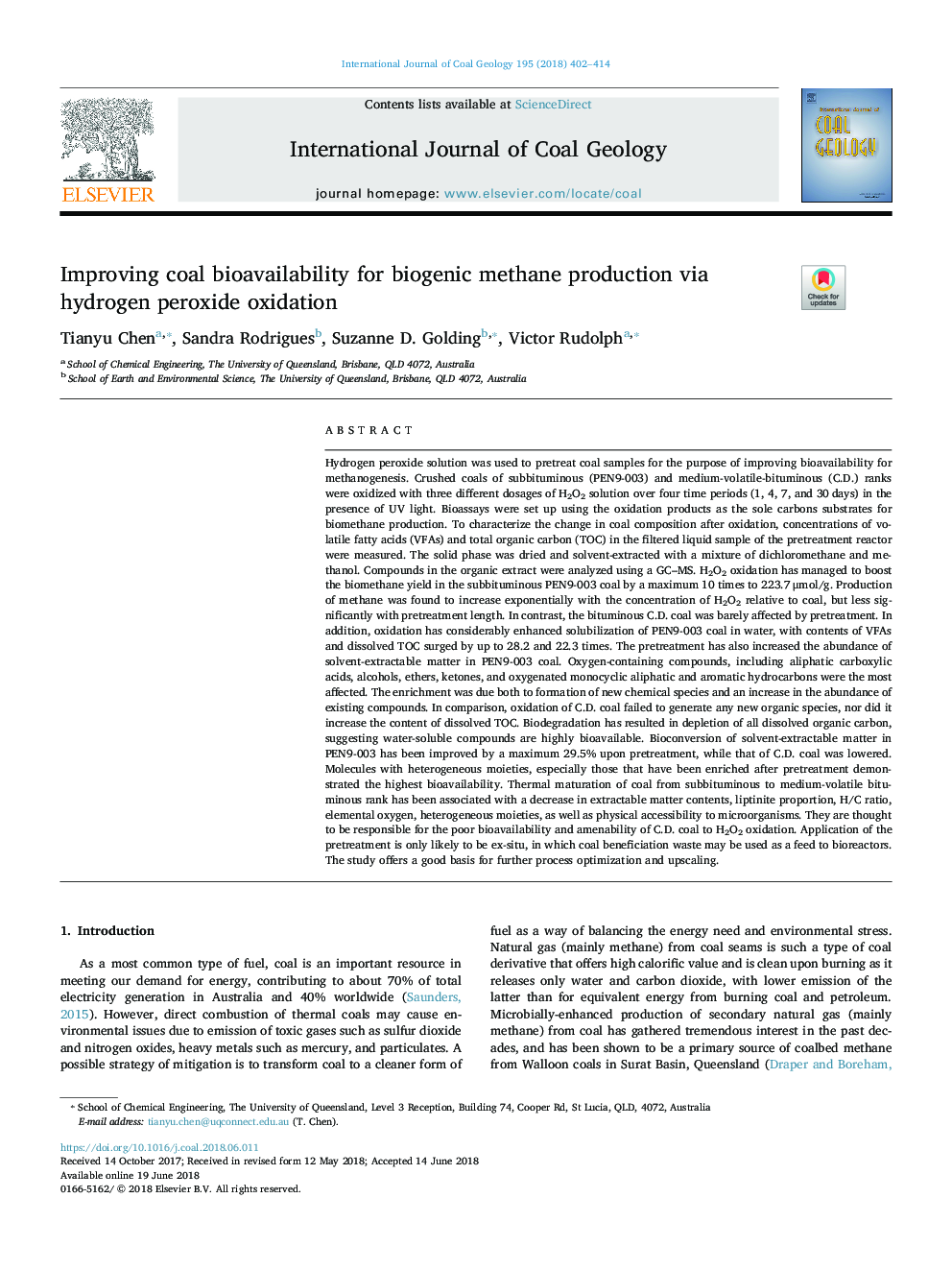| کد مقاله | کد نشریه | سال انتشار | مقاله انگلیسی | نسخه تمام متن |
|---|---|---|---|---|
| 8123322 | 1522508 | 2018 | 13 صفحه PDF | دانلود رایگان |
عنوان انگلیسی مقاله ISI
Improving coal bioavailability for biogenic methane production via hydrogen peroxide oxidation
ترجمه فارسی عنوان
بهبود قابلیت زیستی زغال سنگ برای تولید متان زیستی از طریق اکسیداسیون پراکسید هیدروژن
دانلود مقاله + سفارش ترجمه
دانلود مقاله ISI انگلیسی
رایگان برای ایرانیان
موضوعات مرتبط
مهندسی و علوم پایه
علوم زمین و سیارات
زمین شناسی اقتصادی
چکیده انگلیسی
Hydrogen peroxide solution was used to pretreat coal samples for the purpose of improving bioavailability for methanogenesis. Crushed coals of subbituminous (PEN9-003) and medium-volatile-bituminous (C.D.) ranks were oxidized with three different dosages of H2O2 solution over four time periods (1, 4, 7, and 30â¯days) in the presence of UV light. Bioassays were set up using the oxidation products as the sole carbons substrates for biomethane production. To characterize the change in coal composition after oxidation, concentrations of volatile fatty acids (VFAs) and total organic carbon (TOC) in the filtered liquid sample of the pretreatment reactor were measured. The solid phase was dried and solvent-extracted with a mixture of dichloromethane and methanol. Compounds in the organic extract were analyzed using a GC-MS. H2O2 oxidation has managed to boost the biomethane yield in the subbituminous PEN9-003 coal by a maximum 10 times to 223.7â¯Î¼mol/g. Production of methane was found to increase exponentially with the concentration of H2O2 relative to coal, but less significantly with pretreatment length. In contrast, the bituminous C.D. coal was barely affected by pretreatment. In addition, oxidation has considerably enhanced solubilization of PEN9-003 coal in water, with contents of VFAs and dissolved TOC surged by up to 28.2 and 22.3 times. The pretreatment has also increased the abundance of solvent-extractable matter in PEN9-003 coal. Oxygen-containing compounds, including aliphatic carboxylic acids, alcohols, ethers, ketones, and oxygenated monocyclic aliphatic and aromatic hydrocarbons were the most affected. The enrichment was due both to formation of new chemical species and an increase in the abundance of existing compounds. In comparison, oxidation of C.D. coal failed to generate any new organic species, nor did it increase the content of dissolved TOC. Biodegradation has resulted in depletion of all dissolved organic carbon, suggesting water-soluble compounds are highly bioavailable. Bioconversion of solvent-extractable matter in PEN9-003 has been improved by a maximum 29.5% upon pretreatment, while that of C.D. coal was lowered. Molecules with heterogeneous moieties, especially those that have been enriched after pretreatment demonstrated the highest bioavailability. Thermal maturation of coal from subbituminous to medium-volatile bituminous rank has been associated with a decrease in extractable matter contents, liptinite proportion, H/C ratio, elemental oxygen, heterogeneous moieties, as well as physical accessibility to microorganisms. They are thought to be responsible for the poor bioavailability and amenability of C.D. coal to H2O2 oxidation. Application of the pretreatment is only likely to be ex-situ, in which coal beneficiation waste may be used as a feed to bioreactors. The study offers a good basis for further process optimization and upscaling.
ناشر
Database: Elsevier - ScienceDirect (ساینس دایرکت)
Journal: International Journal of Coal Geology - Volume 195, 1 July 2018, Pages 402-414
Journal: International Journal of Coal Geology - Volume 195, 1 July 2018, Pages 402-414
نویسندگان
Tianyu Chen, Sandra Rodrigues, Suzanne D. Golding, Victor Rudolph,
